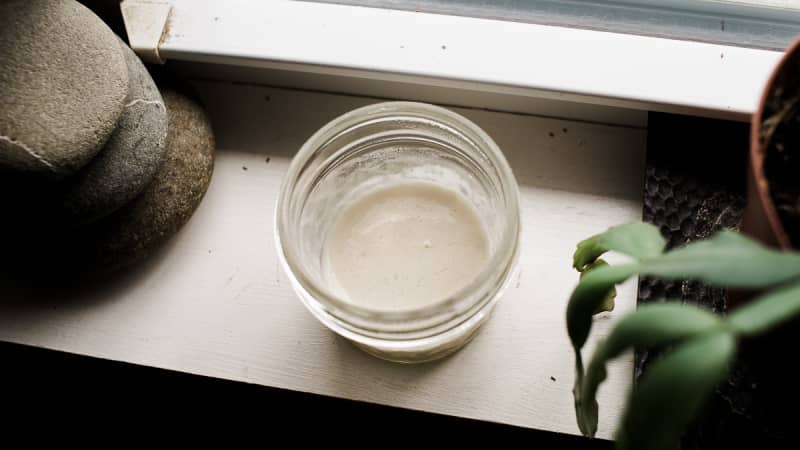Editor's Note: So much has changed with the #QuarantinyStarter method since it first launched that we've removed most of the instructional content here and instead have created a master post with up-to-date and easy-to-follow instructions here. We'll also be adding links to more recipes and additional advice on creating, maintaining, and using your tiny starter, so please watch this space for more!
Make Your Own Mini Sourdough Starter with the #QuarantinyStarter Project
Published Mar. 26, 2020.


How the Quarantiny Starter Project Began
At an early post-quarantine Zoom meeting of the Cook’s Illustrated team, my colleague Andrea Geary mentioned that she was unable to find dried yeast at the grocery store to do some at-home testing of an upcoming dinner roll recipe. I remarked that building a sourdough starter from scratch would be a perfect project right now, with store shelves bare of yeast and lots of time on all our hands.
If you don’t know, a sourdough starter—also called a levain—is a mixture of flour, water, and a collection of wild yeasts and bacteria that together serve to leaven bread. These yeasts and bacteria are naturally present on kernels of wheat and on flour ground from them, but it takes time for them to multiply to the point where they can actually produce a loaf of bread.
The process of creating a sourdough from scratch typically involves mixing flour and water together and then letting the mixture sit for a day or more until the dormant microorganisms on the flour wake up. After that, you “refresh” the nascent culture on a daily basis by moving a portion of it to a new mixture of flour and water and discarding the remainder. Sometime after 2 to 3 weeks or so of doing this, the starter will be ready for prime time. Using a typical recipe—my own Cook’s Illustrated one among them—this might churn though a few pounds of flour, all before baking a single loaf of bread.
But given that even flour is a challenge to find these days, people are unlikely to want to waste it, even if it meant a successful starter at the end of the day. That’s why I wondered: What if instead you could create one using just tiny amounts of flour and conserve the bulk of it for the bread itself?

That’s when “quarantiny starter” was born, made from just 10 grams of all-purpose flour and 10 grams of water.
I shared my tiny starter project idea—a recipe included—to my Instagram account, as well as the Cook’s Illustrated one, and the idea quickly went, well, viral. Within hours, loads of people were sharing pictures of their own micro-levain projects using the hashtag #QuarantinyStarter, and following along with me as I posted updates. Recently I posted a survey to gauge just how many people were participating. As of the first full week there are more than 350 tiny starters going all over the world, even in places as far away as Australia and Malaysia, with new ones starting up every day.
Lots of people were giving their starters names too. Here are just a tiny fraction of my favorites:
Baby Thor
Snots
Quarantiny Dancer
Quarantina Turner
Quentin Quarantino
Smashfist Hammer of Doom
President Roosevelt
Vincent van Dough
Patient Zero
Hazel, Jr.
Adam Levain
Jar Jar Stinks
Maybe you too would like to start a tiny starter of your own, so we are sharing all of my posts here in chronological order. Hopefully this contains all the information you need, but if you have any questions jump over to my Instagram account and ask away!
Meet #QuarantinyStarter, a brand-new sourdough starter, just 2 hours young now. If you don’t have a levain of your own, now’s the perfect time to start one, with time on your hands and supermarket shelves bare of yeast. To conserve flour for when it really matters—baking loaves—we’re doing it with the bare minimum of flour and using whatever flour we have on hand. The first step is just combining flour and water and then waiting patiently for things to wake up.
If you start your own, share results on Instagram using the tag #QuarantinyStarter, so we can all follow along!
Quarantiny Starter Master Plan

Ready to get started? Here's where to find all the info you'll need. GET STARTED
Care and Maintenance of a (Mature) Sourdough Starter

Looking for how to care for your mature sourdough starter? GET THE DETAILS HERE.
Quarantiny Starter Recipes

Almost No-Knead Quarantine Sourdough Boule
Here it is: a relatively simple to make sourdough loaf that utilizes the 100%-hydration quarantiny starters that we all made. GET RECIPE

Sourdough Discard Pancakes
Sourdough pancakes are of course nearly as old as sourdough itself. This recipe uses sourdough discard, but can be made with fresh, fully-proofed sourdough starter as well GET RECIPE

Sourdough Discard Drop Biscuits
Simple-but-delicious drop biscuits, using sourdough discard in place of buttermilk (and flour) for tang and for its acids, which react with the baking soda to produce lift. GET RECIPE

Sourdough Discard Seeded Crackers
Simple-but-delicious crackers, using sourdough discard in place of water and flour, along with whole wheat flour, seeds, and aromatic whole spices for tons of flavor. GET RECIPE
Follow Andrew on Instagram and check back here for more updates on the #QuarantinyStarter project! And for more sourdough recipes and information, check out these pages:
